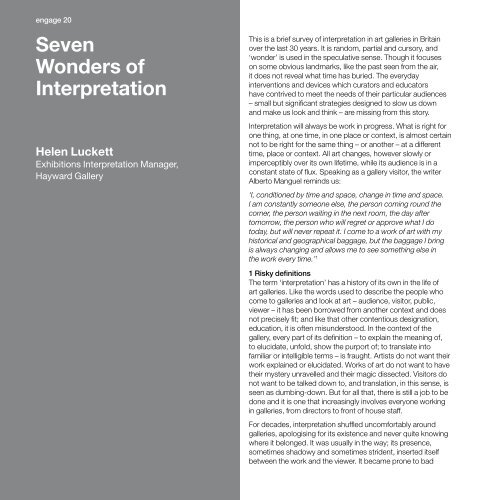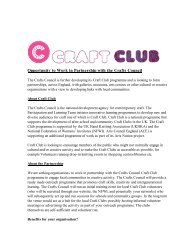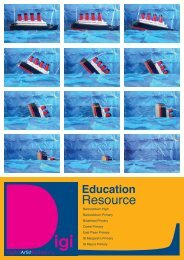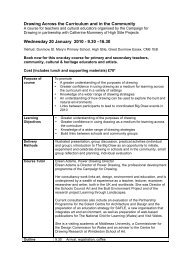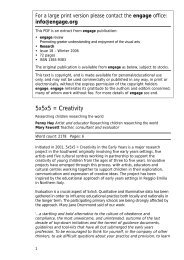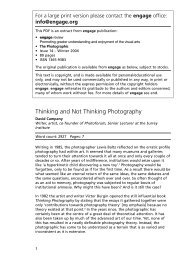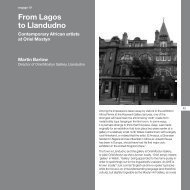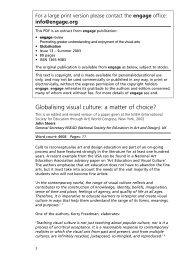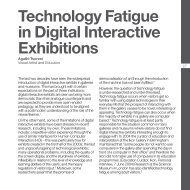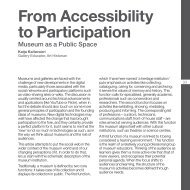Seven Wonders of Interpretation - Engage
Seven Wonders of Interpretation - Engage
Seven Wonders of Interpretation - Engage
Create successful ePaper yourself
Turn your PDF publications into a flip-book with our unique Google optimized e-Paper software.
08The Manchester Art Gallery Ekarved texts present a number<strong>of</strong> distinct voices, but as with most labels these are curatorial:experts speaking to non-experts. Recognising that visitorsmight like to know who the experts were who wrote the labels,Tate has introduced texts which credit the authors. However,the addition <strong>of</strong> a name – or, in some cases, names – seemsmerely to add to the authoritarian weight <strong>of</strong> the message(and hints at curatorial vanity) rather than making the authormore accountable to the public. At the same time, it was alsorealised that non-experts could provide different insights andat Tate Modern celebrities including Terence Conran, BrianEno and Bella Freud have contributed ‘Bigger Picture’ captionswhich sat alongside curatorial labels, providing first-personviews. And at Tate Britain, visitors have been given a right <strong>of</strong>reply in the comments boards which have become a feature<strong>of</strong> the Turner Prize exhibitions. Once described as ‘democracywalls’, these famously outspoken and revealing vox pops sitsomewhere between graffiti and serious comment, and gave uspen-and-paper blogs before anyone knew what blogging was.For the past few years, in a further initiative to involve the publicand to bring the real world and the gallery closer together,visitors to Tate Britain’s website have been invited to WriteYour Own Label, with selected entries used as captions in thegallery. ‘We’d particularly like to hear from visitors who have aspecial interest in the subject matter <strong>of</strong> some <strong>of</strong> Tate’spaintings,’ the site announces. ‘Are you interested in music,fashion, botany, theology or engineering? Have you visited, ordo you live near, a place shown in one <strong>of</strong> the landscapes? Haveyou experienced an event shown in one <strong>of</strong> the paintings?’ Suchmoves have gone some way towards reversing the one-wayflow <strong>of</strong> information from curator to visitor, while tacitly endorsingthe fact that visitors’ own areas <strong>of</strong> expertise and experience maybe <strong>of</strong> value; something that has long been appreciated andacted on in various ways in galleries outside London.The use <strong>of</strong> electronic media as a conduit between the galleryand its wider public in Tate Britain’s ‘write your own label’ projecthas been taken a step further in Leicester, where Dr Ross Parry<strong>of</strong> the Department <strong>of</strong> Museum Studies is developing experimental‘live’ labels. Using wi-fi technology, these replace conventionallabels with small-scale touchscreens. But rather than beingsimply an interactive aid for the visitor, their potential lies inenabling the curator to change, correct, update and add tothe information on a continual basis. Time will tell whether thisbecomes a solace to regretful label-writers, or a stick to beatthem with.3 Spoken wordsWhile galleries can be places for quiet contemplation, they are<strong>of</strong>ten also arenas for audible dialogue, conversation, argument.It was not always so. Until the 1970s, when children started to
engage 20 <strong>Seven</strong> <strong>Wonders</strong> <strong>of</strong> <strong>Interpretation</strong>be both heard and seen and art itself began to incorporatesound, the silent gallery could be deafeningly intimidatingand stupefyingly oppressive, drowning out thought and stiflingimagination. The reverential hush was usually only puncturedby the voice <strong>of</strong> the guide-lecturer, who delivered a monologueand rarely invited a response. The change was gradual, butwhen Tate Liverpool opened in 1988 it took the unprecedentedstep <strong>of</strong> replacing the traditional role <strong>of</strong> museum warder – theuniformed guard who in quieter galleries would while away his(or occasionally her) time studying greyhound racing form– with Live Guides, invigilators trained to talk about the workson show. Two years later, The British Art Show extended thisapproach by recruiting local MA students as Live Guides for itsGlasgow showing. As emerging artists, they were encouragedto see this as an experience which could inform their ownpractice, as well as helping the public. Other galleries began t<strong>of</strong>ollow suit, and when BALTIC opened in 2002 its security staffwere presented as the Crew, a team <strong>of</strong> young people whosejob is both to look after the visitors and the art.Alongside this, a more private form <strong>of</strong> spoken communicationwas evolving. It is surprising now to discover that audio guideswere first introduced to the UK in the early 1960s – and thennot so amazing to realise that their development marched sideby side with technical innovations. It was not until the heftyportable reel-to-reel tape recorders were superseded by anew generation <strong>of</strong> cassette players that audio guides beganto be accepted as a viable interpretative tool, and even thenthe production and hardware were beyond the resources <strong>of</strong>most galleries. Though the efficacy <strong>of</strong> the disembodied voicein the visitor’s ear is widely debated – Does listening take overfrom looking? Does it mess with your head? – further technicaldevelopments have taken audio guides into the realm <strong>of</strong>multimedia, and podcasts have widened their potentialaudience, allowing people outside the gallery to downloadaudio files onto personal digital music players.4 Playrooms and learning zonesSometime in the late 1980s, the term ‘interactive’ weaselledits way into the language and practice <strong>of</strong> interpretation. Ratherthan creative or imaginative give-and-take between artworkand viewer, what it specifically denoted was computer-basedmultimedia. It has since become so embedded in galleryculture that we hardly question its meaning or purpose.Interactives (noun, plural) are hands-on, visitor-friendly.They are also high maintenance: given to breaking down,freezing, crashing and malfunctioning.The first major gallery-based computer interactive was a videodisc developed to complement Tate Liverpool’s opening display<strong>of</strong> modern British sculpture in 1988. Using state-<strong>of</strong>-the-arttouchscreen technology, the interactive disc provided accessto a seemingly inexhaustible trove <strong>of</strong> contextual informationabout hundreds <strong>of</strong> works stored within its fathomless memory.Images, film, radio and archival material were at your fingertips.‘While galleries can be placesfor quiet contemplation, theyare <strong>of</strong>ten also arenas for audibledialogue, conversation, argument.It was not always so.’The National Gallery’s Micro Gallery, which opened with thenew Sainsbury Wing in 1991, provided information on theentire collection, with images <strong>of</strong> every painting. Users couldselect themes and plan their own tours, which they could thenprint out. In 2005 it was re-launched as ArtStart. In its new,higher-tech manifestation it has spilled out from its originalpurpose-built space and, as well as being given an additionalroom <strong>of</strong> its own at the other end <strong>of</strong> the Gallery, now occupiesother areas <strong>of</strong> the Sainsbury Wing. Due to ArtStart’sextraordinarily high-resolution images, the National Galleryis able to claim that ‘no other art institution <strong>of</strong>fers the chance,through technology, to get so close to its paintings.’ Will thereal thing be able to live up to its virtual reality?Investment in interactive multimedia has become a feature<strong>of</strong> gallery redevelopment programmes, particularly thosethat have come about as a result <strong>of</strong> Heritage Lottery funding.Manchester Art Gallery’s major make-over included the CloreInteractive Gallery (supported by the Clore Duffield Foundation).Instead <strong>of</strong> confronting the visitor with a room full <strong>of</strong> computerterminals, this family-oriented space combines cleverlypresentedelectronic interactive games with low-tech, hands-onactivities such as dressing-up and storytelling, and evenincludes real art; each resource relates to a particular workfrom the collection.When Tate Modern’s new Learning Zone opened last year it<strong>of</strong>fered a vast array <strong>of</strong> gallery interactive edutainment, in whatTate described as an ‘integrated learning environment’. Itsscale and scope were awe-inspiring. It had copious space,09
10was lavishly designed and caused serious envy in colleaguesfrom other institutions. But while most <strong>of</strong> us can only dream<strong>of</strong> having the same overall level <strong>of</strong> resources, this amazingextravaganza provided a shop window <strong>of</strong> pick-’n-mixpossibilities; some to emulate and some to pass by.5 The whole world in your handThe hand-held multimedia tour is only as old as this century.Combining aspects <strong>of</strong> wall labels, exhibition catalogues,audio-guides, and interactive programmes and games,it uses location-sensitive wireless technology to feed the visitoreverything they could possibly need wherever they are in thewired-up gallery. Video and still images, sound and text areavailable, plus the ability to talk (or at least send text messages)back. The information it can provide is practically limitless.While visitors may burst at the seams with this informationoverload, the medium puts increasing pressure on curatorsand educators to come up with the goods: more and morearchival and contextual material, ever-more elaborateapproaches. Enlightenment becomes heavier and heavier.Tate began it, and in its own words ‘continues to lead theinternational field in this use <strong>of</strong> cutting-edge technology forgallery interpretation.’ Other big institutions have leapt onboard. (Among the many resources included in the multimediatour accompanying the V&A’s recent exhibition Leonardo daVinci: Experience, Experiment and Design were an MRI scanand modern realisations <strong>of</strong> Leonardo’s designs for musicalinstruments, recreated by a potter.) It is cheering to see howa small gallery can both keep up with the trend and in manyrespects overtake it. Dulwich Picture Gallery’s entirelyhome-grown DiGIT programme, initially developed as aneducational tool for young people, aims to encourage activeobservation and discussion, asking questions which are‘sometimes funny, sometimes provocative, and always thoughtprovoking’. Rather than attempting to provide all the answers,it suggests follow-up activities and resources which studentscan research themselves.6 AmbienceIn the rush to supply information in every conceivable mediumand format, it is easy to overlook the impact <strong>of</strong> art’s physicalsurroundings and the effect that these may have on galleryvisitors. The buildings themselves can be intimidating, bothinside and out. The Independent’s reviewer Thomas Sutclifferecently drew attention to the phenomenon <strong>of</strong> Schwellenangst:‘It means fear <strong>of</strong> the threshold and, as I understand it, refers tothe spasm <strong>of</strong> doubt that can afflict you when you step over ademarcation between public and private space. Or even thedemarcation between a public space and a public space, forthat matter.’ He went on to say that though he was ‘long pastexperiencing Schwellenangst at the threshold <strong>of</strong> a theatre or anarts centre, there is one place where it still persistently strikes.At the door to any major art exhibition – contemporary orclassical – I feel a tremor <strong>of</strong> inadequacy, an uncertainty as towhether this is really for the likes <strong>of</strong> me.’
engage 20 <strong>Seven</strong> <strong>Wonders</strong> <strong>of</strong> <strong>Interpretation</strong>It has taken some time for gallery design to take properaccount <strong>of</strong> the needs <strong>of</strong> the art, let alone the viewer. In the1970s the Arts Council 2 insisted that galleries taking itsexhibitions and loans <strong>of</strong> large-scale contemporary paintingsmust hang them on clean white walls, instead <strong>of</strong> dingy,pock-marked hessian. Though this radical move was as muchto the viewer’s advantage as to the works <strong>of</strong> art, the austerewhite space <strong>of</strong>ten proved as uninviting as the grim, badly-litgallery it replaced. While the bad old galleries generally hadseating (<strong>of</strong>ten clustered around huge radiators), the newgalleries had none. The visitor was stranded in pristineemptiness, unsure how to behave. Things got worse ascontemporary art seemed to produce more and more visualbanana skins.In 1982 a group <strong>of</strong> seven-year-old children at SouthamptonArt Gallery considered the problem <strong>of</strong> getting adults toovercome their reluctance to spend time with contemporary art.They suggested that visitors should be provided with a bagcontaining necessities such as new eyes, a new brain, and lips(for asking questions, and for smiling), as well as mats so thatthey could kneel down and look at things from differentperspectives, and maps to take them on interesting routesaround the works. But they realised that even with all theseamenities visitors would only really begin looking if they feltmore at home. Comfortable chairs and a friendly atmospherewere the most important provisions.Perhaps it is only once visitors have experienced this sort<strong>of</strong> welcome that they will have the confidence to appreciatea deliberately uncomfortable experience, designed to provokedisquiet and unease (or to tease), which is increasingly thegoal <strong>of</strong> exhibitions <strong>of</strong> new art.7 Oblique strategiesNot strictly part <strong>of</strong> interpretation’s brief, and probably the moreeffective as a result, these and numerous other tactics havebeen used in galleries nationwide since the 1970s:• Eavesdropping: run an event for children in order thatadults may surreptitiously benefit (not known to work theother way round)• Appoint an artist in residence• Appoint a writer in residence• Write labels that ask (open) questions• Make a deliberate mistake in a label – if the label’s worthreading you will soon hear about it• Write a label for the fire-hose/ventilation grill/thermohygrograph that people frequently mistake foran artwork• Use positive signage: Please Touch; Please Walk Across theArt Work; Please AskThis is just a start. Please add your own examples.Notes1 Manguel, A. (1998), ‘The Muse in the Museum’, in Into the Looking-Glass Wood:essays on books, reading, and the world. Toronto: Alfred A. Knopf. The quotationcontinues, ‘Therefore I don’t trust the labels. A work <strong>of</strong> art itself carries nojudgement.’2 The history <strong>of</strong> Arts Council Touring Exhibitions goes back to 1942, when theCouncil for the Encouragement <strong>of</strong> Music and the Arts began to circulate artexhibitions to galleries, museums and other venues in the UK. These in turn hadtheir origins in the British Institute <strong>of</strong> Adult Education’s experimental travellingexhibitions, Art for the People, which toured from 1933 to 1944 to towns whichwere ‘too small or too poor’ to possess an art gallery. In the 1970s the Arts Councilextended the scope and range <strong>of</strong> its touring exhibitions programme, includingshows <strong>of</strong> cutting-edge contemporary work, which were intended to be challenging,alongside more ‘accessible’ exhibitions. In 1979, an Art Education Officer wasappointed to work specifically with Arts Council Touring Exhibitions, and in 1984,the Arts Council’s ‘Glory <strong>of</strong> the Garden’ regional development strategy for the visualarts assisted the establishment and funding <strong>of</strong> many new curatorial and educationposts across the country, each with a particular remit to work with contemporary artand its interpretation. <strong>Interpretation</strong> had always been at the heart <strong>of</strong> the ArtsCouncil’s touring exhibitions: in the early days, each exhibition was accompanied bya lecturer who travelled with the show to all its venues. Since 1987, when theHayward Gallery and Arts Council Touring Exhibitions were devolved to the SouthBank Centre, the touring programme has undergone various changes <strong>of</strong> identity.After first becoming South Bank Centre Touring, its name was changed to NationalTouring Exhibitions. It is currently known as Hayward Touring.Images in order <strong>of</strong> appearance1 <strong>Interpretation</strong> in the exhibition Paul Klee: The Nature <strong>of</strong> Creation at the HaywardGallery in 2002. Visitors watch a flash movie downstairs, while local GCSEstudents, trained (by an artist) to act as live guides, are glimpsed at the window inthe upper room. (Photo: Liane Harris)2 Enough to induce Schwellenangst? Gallery doors, as depicted on the cover <strong>of</strong> aguide for young visitors to Aberdeen Art Gallery, c.19803 Need you know more? ‘Basic’ label for a work in the National Touring ExhibitionYou’ll Never Know: Drawing and Random Interference, 2006. A separate labelexplained that this was one <strong>of</strong> a series <strong>of</strong> screenprints using food and other organicmaterials.4 ‘At Southampton Art Gallery lots <strong>of</strong> grownups look at a picture for about fiveseconds, so I decided to make a trap to make them stay longer. A person goes intoone <strong>of</strong> the galleries and puts 5p by the picture, and out comes a chair and someangel cake and a cup <strong>of</strong> tea. By drinking the tea and eating their cake they look atthe picture.’ Gary Houghton (aged 7), 198211


